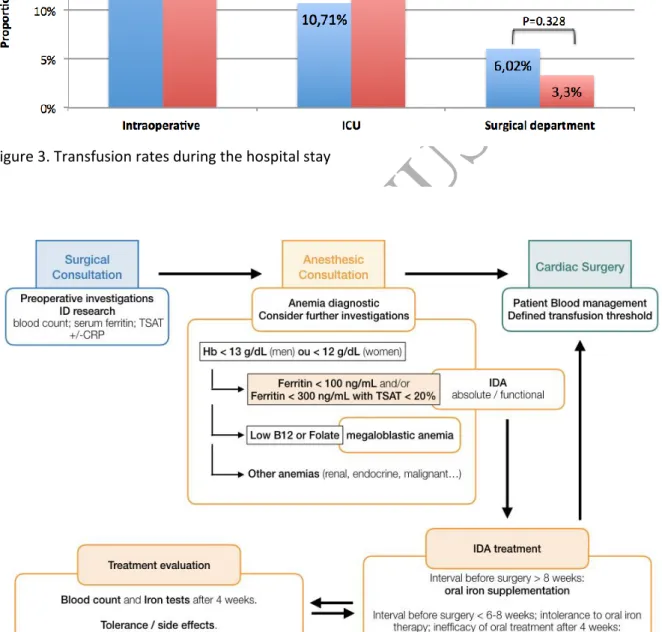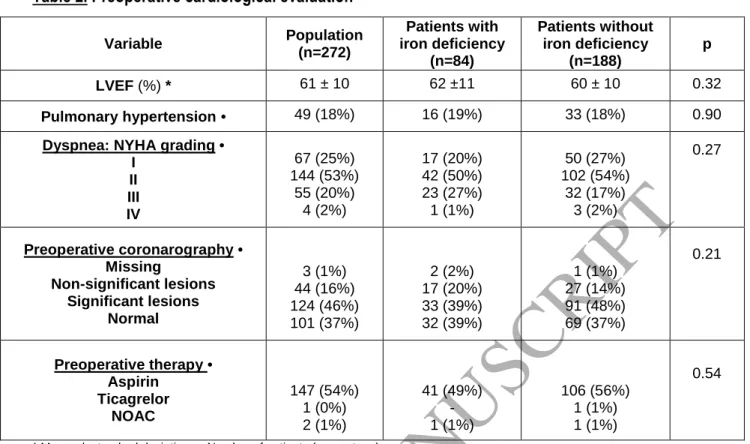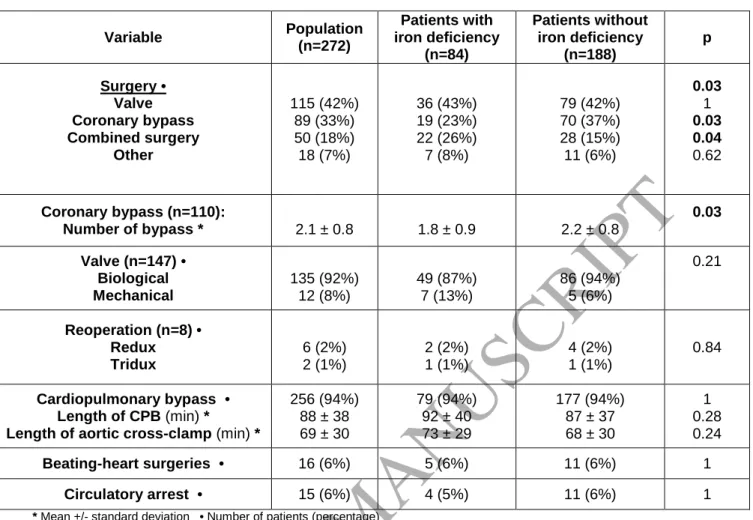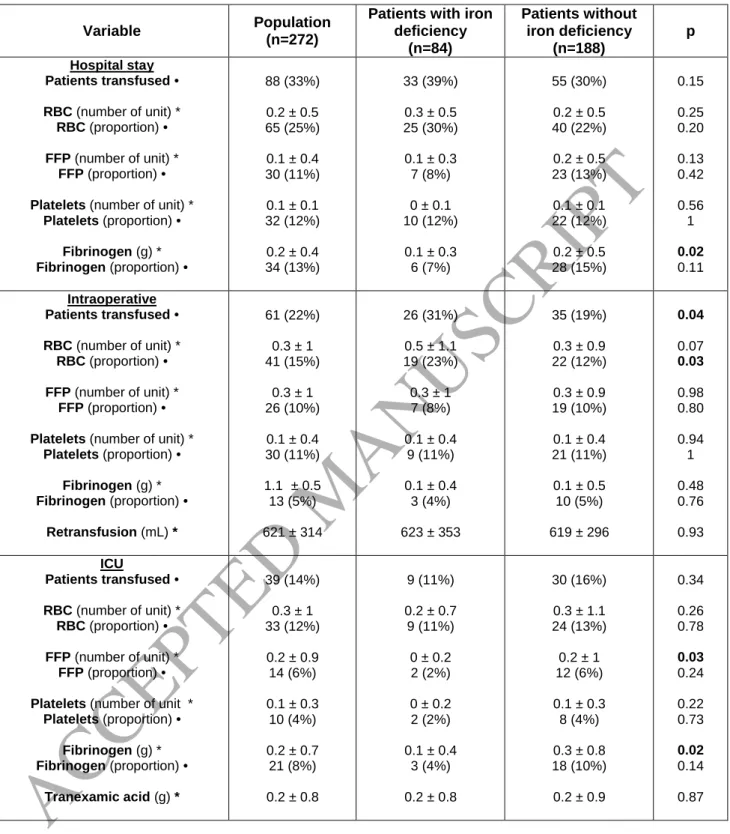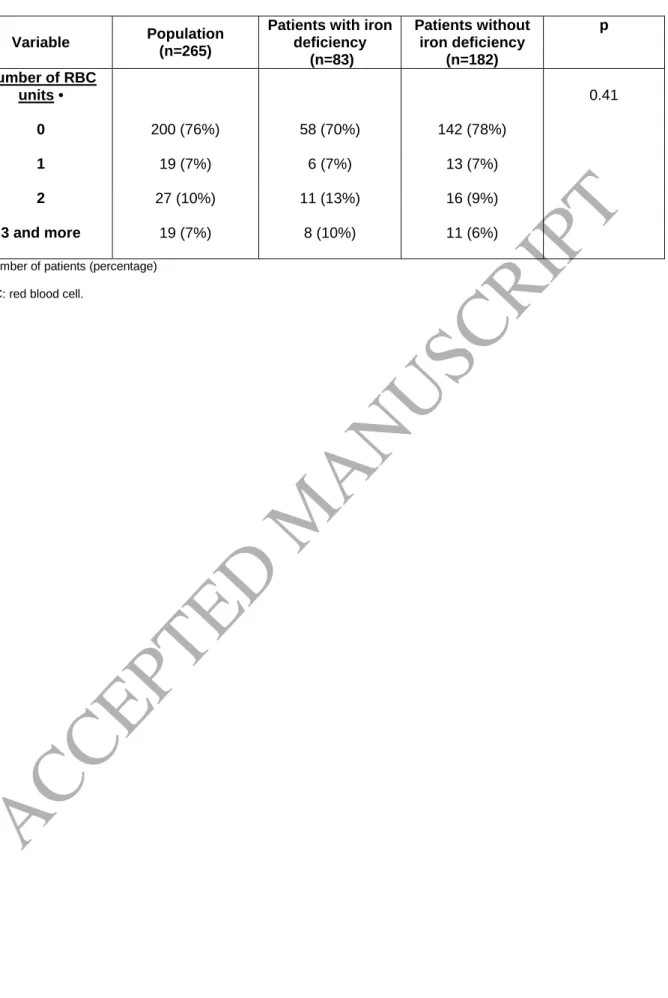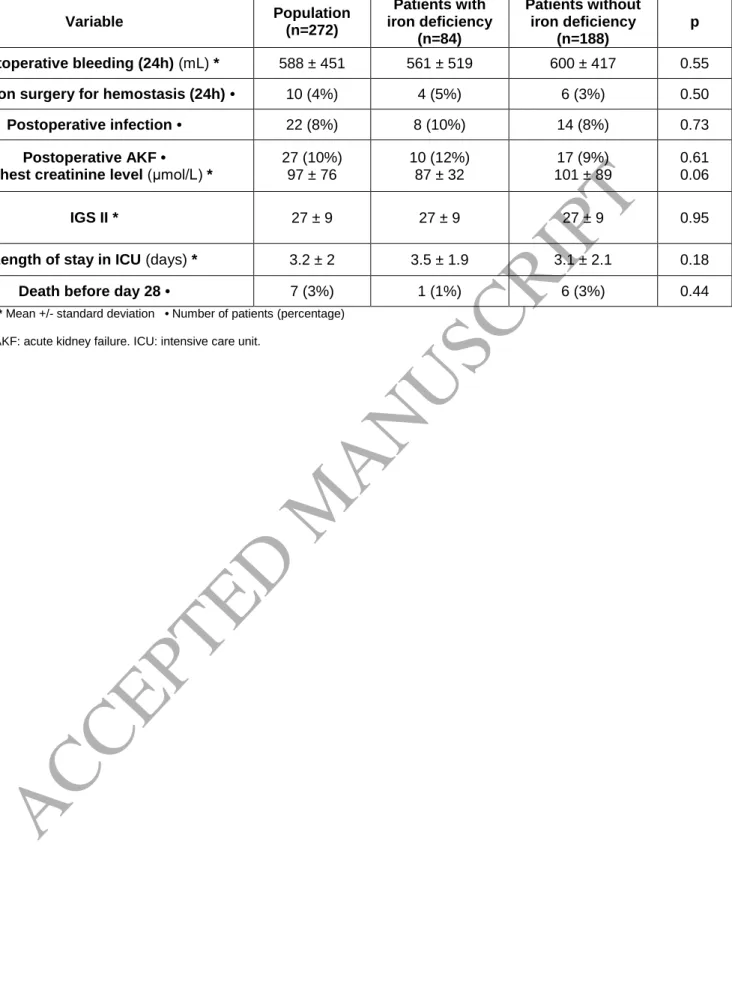HAL Id: hal-02086792
https://hal-univ-rennes1.archives-ouvertes.fr/hal-02086792
Submitted on 23 May 2019HAL is a multi-disciplinary open access archive for the deposit and dissemination of sci-entific research documents, whether they are pub-lished or not. The documents may come from teaching and research institutions in France or abroad, or from public or private research centers.
L’archive ouverte pluridisciplinaire HAL, est destinée au dépôt et à la diffusion de documents scientifiques de niveau recherche, publiés ou non, émanant des établissements d’enseignement et de recherche français ou étrangers, des laboratoires publics ou privés.
Marine Hubert, Baptiste Gaudriot, Sebastien Biedermann, Hervé Gouezec,
Emmanuelle Sylvestre, Guillaume Bouzillé, Jean-Philippe Verhoye, Erwan
Flecher, Claude Ecoffey
To cite this version:
Marine Hubert, Baptiste Gaudriot, Sebastien Biedermann, Hervé Gouezec, Emmanuelle Sylvestre, et al.. Impact of Preoperative Iron Deficiency on Blood Transfusion in Elective Cardiac Surgery. Journal of Cardiothoracic and Vascular Anesthesia, WB Saunders, 2019, 33 (8), pp.2141-2150. �10.1053/j.jvca.2019.02.006�. �hal-02086792�
ACCEPTED MANUSCRIPT
Impact of preoperative iron deficiency on blood transfusion in elective cardiac surgery
Marine Hubert1, Baptiste Gaudriot1, Sebastien Biedermann1, Hervé Gouezec2, Emmanuelle Sylvestre3 4, 5, 6
, Guillaume Bouzille3, 4, 5, 6, Jean-Philippe Verhoye7, 8, Erwan Flecher7, 8, and Claude Ecoffey1, 4, 7.
1. CHU Rennes, Anesthésie-Réanimation CTCV, F-35033 Rennes, France
2. CHU Rennes, Hémovigilance et Sécurité Transfusionnelle, F-35033 Rennes, France 3. INSERM, U1099, F-35000 Rennes, France
4. Inserm CIC-1414, F-35000 Rennes, France
5. CHU Rennes, Centre de Données Cliniques, F-35033 Rennes, France 6. Université de Rennes 1, LTSI, F-35000 Rennes, France
7. Université de Rennes 1, Faculté de Médecine, F-35000 Rennes, France
8. CHU Rennes, Chirurgie Thoracique et Cardiovasculaire, F-35033 Rennes, France
Corresponding author:
Baptiste Gaudriot, Service d’Anesthésie-Réanimation CTCV, Centre Cardio-Pneumologique, Hôpital Pontchaillou, 2 rue Henri Le Guilloux, 35033 Rennes Cedex 9, France.
(E-mail: baptiste.gaudriot@chu-rennes.fr)
Funding :
This research did not receive any specific grant from funding agencies in the public, commercial, or not-for-profit sectors.
Declarations of interest: None.
Impact of preoperative iron deficiency on blood transfusion in elective cardiac surgery
ACCEPTED MANUSCRIPT
Objective: To evaluate the incidence and consequences of preoperative iron deficiency in elective cardiac surgery.
Design: A prospective observational study.
Setting: The cardiac surgery unit of a university hospital, from November 2016 to February 2017. Participants: All patients presenting for elective cardiac surgery during the study period, with the exclusion of non-cardiac thoracic surgeries, surgeries of the descending aorta, endovascular
procedures, and patients affected by an iron-metabolism disease.
Intervention: Transferrin saturation and serum ferritin levels were systematically assessed before surgery and the care of patients maintained as usual.
Measurements and Main Results: Routine analyses, clinical data, and the number of blood transfusions were recorded during the hospital stay. Among the 272 patients included, 31% had
preoperative iron deficiency, and 13% were anemic. Patients with iron deficiency had significantly
lower hemoglobin levels throughout the hospital stay and received blood transfusions more
frequently during surgical procedures (31% vs. 19%, p = 0.0361). Detailed analysis showed that
patients with iron deficiency received more red blood cell units. There were no differences in
postoperative bleeding, morbidity, or mortality.
Conclusions: Iron deficiency appears to be related to lower hemoglobin levels and more frequent transfusion in elective cardiac surgery. Assessing iron status preoperatively and correcting any iron
deficiencies should be one of the numerous actions involved in patient blood management for such
surgeries, with the aim of reducing morbidity due to both anemia and transfusion.
Key words:
ACCEPTED MANUSCRIPT
Impact of preoperative iron deficiency on blood transfusion in elective cardiac surgery
Introduction
Blood transfusion is a major concern in cardiac surgery. Indeed, the risk of hemorrhage is an
important issue during both intraoperative (sternotomy, cardiopulmonary bypass (CPB) and the
accompanying required anticoagulation, and induced thrombopathy) and postoperative periods
(coagulation and fibrinolysis disorders, postoperative bleeding, mediastinal drain clotting, pericardial
tamponade, etc.). It often concerns elderly and vulnerable patients, who have a low tolerance to
anemia. Although guidelines have been published to help clinicians with blood transfusion (1-3),
especially for thoracic surgery (4-5), the proportion of patients that receives a perioperative blood
transfusion still depends on the type of surgery, the center, and the designated hemoglobin
thresholds (6-14). It can vary from 8 to 93% (15). The statistics of morbidity and mortality related to
blood transfusion are well established in cardiac surgery (8-10; 16-19). For example, an English
cohort showed that red blood cell (RBC) transfusion was associated with an increased incidence of
infections (septicemia and pulmonary tract infections), ischemic complications (acute coronary
syndrome and stroke), and acute renal failure, resulting in an increase in hospital length of stay and
costs, and increased short- and medium-term mortality (20).
Anemia, defined by the World Health Organization (WHO) as a hemoglobin level < 13 g/dL
for men and < 12 g/dL for women, occurs in 10 to 11% of patients older than 65 years of age in the
general population (21), and 26% of patients presenting for cardiac surgery (22). Anemia is an
independent factor of morbidity, mortality, and perioperative blood transfusion (23,24). Among
patients presenting for coronary bypass surgery, a hematocrit level < 33% is associated with
significantly higher rates of acute renal failure, stroke, mediastinitis, and longer duration of
ACCEPTED MANUSCRIPT
Iron deficiency (ID), defined by a serum ferritin level < 100 ng/mL, or < 300 ng/mL in
association with transferrin saturation < 20% (26), is the most common cause of anemia (27). Half of
patients with cardiac heart failure have ID (28), as well as 37% of patients presenting for cardiac
surgery. It is an independent factor of blood transfusion and postoperative fatigue (29). ID can be
easily treated by iron supplementation. Indeed, ferric carboxymaltose improves the exercise
capacity, cardiac function, and quality of life of patients with chronic heart failure (30).
Preventing complications and morbidity due to anemia and blood transfusion is a key
element in cardiac surgery and requires a patient blood-management (PBM) strategy (31), including
the correction of ID as a major component. We aimed to evaluate the incidence of preoperative ID
and ID anemia (IDA) in our population of patients presenting for elective cardiac surgery, as well as
secondary outcomes to evaluate its association with blood transfusion (all transfusions and that of
RBCs, plasma, and platelets), hemoglobin levels, and mortality during the hospital stay.
Patients & Methods
Patient population
We determined the size of the study population based on retrospective observations in our
surgery population and published data. Considering that: a) approximately 20% of the patients in our
population appeared to suffer from anemia, b) ID affects 37% of cardiac surgery patients (29), and c)
ID is the first cause of anemia, we hypothesized that anemia would be found in 15% of patients
without ID and 25-30% of ID patients. With an risk of 5% and at 20%, the number of patients to be included was 242 or more. We expected to include 20 patients per week and planned the
inclusions over 3.5 months.
We conducted this prospective observational study from November 14, 2016 to February 26,
ACCEPTED MANUSCRIPT
CPB, was included prospectively. Exclusion criteria were: patients younger than 18 years of age or
legally protected adults, endovascular procedures (trans-aortic valve replacement (TAVR) and all
percutaneous techniques), non-cardiac thoracic surgeries, surgeries on the descending aorta, and
patients affected by an iron metabolism disease or for whom preoperative iron status could not be
determined.
Study procedures and data collection
We assessed cardiac function (symptoms, echocardiography, and coronarography),
cardiovascular risk factors, respiratory function (symptoms and lung-function test), and vascular
diseases (symptoms and supra-aortic vessel echography), according to our routine preoperative
evaluation. A blood sample was systematically collected several days before surgery and the blood
count, platelet count, and coagulation factors were determined, and an ionogram, including the
serum creatinine level and glomerular filtration rate (estimated by the CKD – EPI formula),
performed. Serum ferritin, transferrin, and iron levels were systematically determined during the
study. Transferrin saturation (Tsat) was calculated as follows: Tsat (%) = serum iron (mol/L)/(serum
transferrin (g/L) x 25).
A central venous catheter in the cava superior territory (or a Swann-Ganz catheter for the
most vulnerable patients) and a radial arterial catheter were placed in every patient. The
management of CPB (cannulation, cardioplegia, tubes, and cardiotomy reservoir) varied, depending
on the choices of the surgeon and perfusionist. The modality of general anesthesia was decided by
the anesthesiologist.
Blood loss and transfusion during surgery were prevented, according to our institutional
protocol, as follows: a) tranexamic acid was injected at a dose of 2.5 g during the induction of general
anesthesia and at the end of CPB as an antifibrinolytic agent; b) intraoperative cell salvage was
systematically performed, if not contraindicated (Cell-Saver®, Haemonetics); and c) anticoagulation
ACCEPTED MANUSCRIPT
time (ACT), with a target of 450 seconds during CPB. Calculations were performed by Heparin
Management System-Plus (HMS-Plus®, Medtronic Inc.) during surgery, based on an algorithm that
includes the prime volume and patient morphology. The appropriate dose of protamine required
after decannulation was calculated using the same device. The decision to perform a blood
transfusion was made by the anesthesiologist if the hematocrit decreased to 22% during CPB, for
cold crystalloid cardioplegia, or 22-25%, for warm blood cardioplegia, and was based on the French
recommendations on hemoglobin levels for the following postoperative period (2).
During the postoperative period, every patient was admitted to the intensive care unit (ICU)
for at least 48 hours with daily clinical, biological, and echocardiographic evaluations. Data were
collected prospectively through a data collection form, completed by the anesthesiologists in charge
of the patient. After the ICU period, patients were transferred to the surgery unit and data were
collected through the patient computerized folder.
The study protocol was approved by the ethics committee of the university hospital (notice
n° 16.121 of October 7, 2016). Patients received oral and written information before their inclusion,
and written consent was required.
Statistical analysis
We compared two groups of patients defined by their ID status, as previously described. The
descriptive analysis was performed using R® software, version 3.3.2. Quantitative variables are
presented as the mean +/- standard deviation (SD), with the number of patients (n). Groups were
compared using the parametric t test of Student or the non-parametric test of Wilcoxon, depending
on the number of patients analyzed. Categorical variables are presented as the number of patients
by percentage: n (%). We compared the groups using the χ2 test or Fisher’s exact test, depending on
ACCEPTED MANUSCRIPT
Results
The flowchart of the study is shown in Figure 1. The general characteristics and preoperative
cardiological evaluation of the population are shown in Tables 1 and 2. In our population (n = 272),
31% of patients had preoperative ID. There were no differences between the two groups, apart from
the number of women and smaller size of the individuals, who were more likely to be in the ID group.
Most of the surgical procedures were cardiac valve replacements and coronary bypasses Table 3).
Among valve replacements, most concerned the aortic valve (35% of surgeries); only 7% were mitral
valve surgeries (replacement or plasty) and only one tricuspid surgery was performed during the
study period. We practiced significantly more coronary bypasses and fewer combined surgeries in
the group without ID.
Iron deficiency lowers hemoglobin levels
Thirteen percent of the patients had anemia before surgery. Hemoglobin levels were
significantly lower among patients with ID throughout their hospital stay (Figure 2) and the
proportion of anemic patients among them was greater (19% vs. 10%, p = 0.066) (Table 4). The
non-ID group contains two kinds of patients: those with ferritin levels > 300 ng/mL and those with Tsat >
20%. Some of them thus present with a ferritin level between 100 and 300 ng/mL but a Tsat > 20%,
as well as others with a Tsat < 20% but a ferritin level > 300 ng/mL.
Iron deficiency increases the risk of blood transfusion
Patients with preoperative ID were more likely to receive a blood transfusion during the
intraoperative period, including that of RBCs, fresh frozen plasma, platelets and fibrinogen (Figure 3).
Furthermore, the number of RBC transfusions was significantly higher during the intraoperative
ACCEPTED MANUSCRIPT
A more detailed analysis of RBC transfusion showed that patients without ID generally
received one or two units of RBCs, whereas patients with ID were more likely to receive two or more
units (Table 6). However, only 29% of patients transfused with RBCs received three units or more (7%
of the study population), and there was no difference between the two groups. This statistical
analysis only covered patients who were still alive at the end of hospital stay (n = 265).
An analysis of postoperative complications showed no difference between patients with or
without ID (Table 7).
Discussion
The prevalence of ID in our study was 31%, similar to previously published data (29). ID is the
most frequent cause of anemia worldwide (27) and is responsible for microcytic, hypochromic, and
regenerative anemia. ID is defined by serum ferritin levels < 100 ng/mL or < 300 ng/mL, when
associated with transferrin saturation < 20% (26), defining two different types of ID: absolute and
functional. Iron levels in the blood are regulated by the hormone hepcidin (32). Hepcidin inhibits
intestinal iron absorption and regulates iron distribution in the tissues by inducing the degradation of
its receptor, the cellular iron exporter ferroportin (33). The synthesis of hepcidin increases with
inflammation (cancer, inflammatory bowel disease, chronic cardiac dysfunction, etc.), resulting in a
decrease of circulating iron levels and causing functional iron deficiency, whereas serum ferritin
levels often increase. Surgery and CPB also cause inflammation, resulting in the production of
mediators that decrease erythropoiesis, causing anemia. Numerous mechanisms are involved: an
increase in hepcidin synthesis, increased macrophage activity and phagocytosis of RBCs, inhibition of
erythropoietin synthesis, and decreased sensitivity of erythroblasts to erythropoietin (32). These
phenomena all lead to decreased hemoglobin levels, preoperative anemia, surgical blood loss, and
ACCEPTED MANUSCRIPT
There was a higher prevalence of preoperative anemia among patients with ID, although it
was not significant. Hemoglobin levels and the hematocrit during CPB were both significantly lower
for patients with ID throughout their hospital stay. Indeed, their hemoglobin levels before surgery
were, on average, 0.7 g/dL lower than those of the other group and this gap remained the same until
hospital discharge. We suspect that this gap likely explains the higher frequency of blood transfusion
for ID patients, in particular during the intraoperative period and CPB, which results in hemodilution,
as the groups were comparable in terms of known hemorrhagic risk factors (length and complexity of
the surgery, circulatory arrest, and preoperative antithrombotic treatment) and postoperative
hemorrhagic complications.
The frequency of intraoperative transfusions was low in our cohort (22%) relative to that in
the literature. It was however significantly higher for patients with ID than those without (31% vs.
19%, p = 0.04), but this difference disappeared during the postoperative period, for which the
frequency was still relatively low (14% in the ICU and 4% in the surgical department). ID patients also
more frequency underwent RBC transfusion during surgery (23% vs. 12%, p = 0.03) and this trend
continued during the postoperative period, but it was not significant (30% vs. 22%, p = 0.20). As
previously described (22, 29), anemia was an independent risk factor of blood transfusion in our
cohort, regardless of iron status. The number of units transfused was remarkably low and 7% of
patients of both groups received only one unit of RBCs, whereas patients with ID were more likely to
receive two units or more (23% vs. 15%).
The decision to perform a transfusion was left to the anesthesiologist in charge of the
patient. The thresholds for RBC transfusion in our department are restrictive and are a component of
a PBM strategy. In the current French guidelines, the transfusion threshold in the context of acute
anemia for surgery and critical care is below 7 g/dL for patients with no particular history and 10 g/dL
for vulnerable patients who cannot tolerate lower levels of hemoglobin and those with acute
coronary insufficiency or cardiac failure. A threshold of 8-9 g/dL during the perioperative period is
ACCEPTED MANUSCRIPT
Blood Banks (AABB) has recommended a restrictive blood transfusion strategy, with a threshold of 7
g/dL, even in the ICU, except in the context of acute coronary syndrome, severe thrombocytopenia,
or high hemorrhage risk situations (3). In the context of orthopedic and cardiac surgery, the minimal
threshold rises to 8 g/dL or a hematocrit of 25%. The use of antifibrinolytic agents, such as
tranexamic acid, is also recommended to prevent RBC transfusions for cardiac surgeries with CPB,
orthopedic surgeries associated with a high risk of hemorrhage, and hepatic surgeries (34). RBC
transfusion should be performed one unit at a time, if possible. Our practices are in line with national
and international guidelines.
Platelet transfusion during surgery is mainly based on preoperative thrombopenia (platelets
< 150 G/L) and an extended period of CPB (> 120 – 140 minutes). In this situation, as well as during
surgery of the ascending aorta with circulatory arrest, platelet transfusion is often associated with
the use of fibrinogen. The transfusion of fresh frozen plasma (FFP) is generally based on
abnormalities observed in preoperative coagulation tests (aside from those due to antithrombotic
therapy) and an extended period of CPB. The transfusion of FFP, platelets, or fibrinogen can also be
based on surgical observations (intraoperative hemorrhage, seepage, or hemostasis difficulties) or
abnormalities observed in new coagulation tests, such as thromboelastometry. Our results show that
non-deficient patients received more FFP and fibrinogen in the ICU than other patients. This is likely a
consequence of the low incidence of transfusion and the low number of transfused patients, and not
clinical factors.
Morbidity and mortality induced by blood transfusion have been widely documented (8-10;
16-19). Koch et al. suggested that RBC transfusion is associated with a higher risk of mortality, acute
kidney injury (AKI), prolonged mechanical ventilation, cardiac complications, and postoperative
neurological complications (35). In the non-inferiority study TRACS (Transfusion Requirements After
Cardiac Surgery), published in 2010, a restrictive strategy (a hematocrit ≥ 24%) led to less transfusion
than a liberal strategy (hematocrit threshold of 30%), without any difference in mortality at day 30.
ACCEPTED MANUSCRIPT
distress syndrome, acute kidney failure requiring temporary renal dialysis) and mortality at day 30
with a hazard-ratio of 1.2, regardless of the chosen strategy (36). For cardiac surgery, the risk of AKI
increased by 60% in the context of moderate preoperative anemia (10 to 12 g/dL) and by 8% for each
transfused RBC unit (37). The incidence of postoperative acute kidney failure in our study was low
(10%) and does not appear to be related to the preoperative iron status. There was also no
significant difference between the two groups of patients concerning the prognostic score for the
first 24 hours in the ICU (IGS2 score), the incidence of postoperative infections, or mortality during
the first month. However, these were only secondary objectives, and the incidence of these
complications was relatively low in elective surgery; our study would have needed to include more
patients to show a possible difference.
A PBM strategy is recommended to favor the restricted use of blood transfusion and needs
to be applied at every step of patient care (38,39). In cardiac surgery, this strategy includes
unit-by-unit blood transfusion, volume reduction of the circuit used for CPB, intraoperative retransfusion,
and administration of antifibrinolytic drugs. Such a strategy results in reduced blood transfusion,
postoperative AKI, and length and cost of hospital stay (31,40). Since 2016, experts from the French
Society of Anesthesiology and Critical Care have recommended determining blood counts to detect
ID three to four weeks prior to surgery for elective cardiac and non-cardiac procedures with a high
risk of hemorrhage. In cases of ID, intravenous administration of iron should be performed at least 21
days before surgery (41). The correction of preoperative ID could increase hemoglobin levels before
surgery, thus avoiding the transfusion of one or two RBC units, particularly in the operating room.
This needs to be confirmed by further studies in the context of cardiac surgery.
In conclusion, ID is common in elective cardiac surgery patients and associated with anemia
and increased RBC transfusion. Although transfusions appear to have decreased during the last few
years, due to restrictive strategies and improvements in the surgical and anesthetic management of
patients, detecting and correcting preoperative ID prior to surgery, as part of a PBM strategy, could
ACCEPTED MANUSCRIPT
suggest establishing a clinical pathway from decision to operate to hospital discharge that is centered
ACCEPTED MANUSCRIPT
References
1. American Society of Anesthesiologists Task Force on Perioperative Blood Management. Practice
guidelines for perioperative blood management: an updated report by the American Society of
Anesthesiologists Task Force on Perioperative Blood Management. Anesthesiology
2015;122:241-275.
2. SFAR - Société Française d’Anesthésie et de Réanimation. Transfusion de globules rouges
homologues : produits, indications alternatives. 2015. Available at
http://sfar.org/transfusion-de-globules-rouges-homologues-produits-indications-alternatives/
3. Carson JL, Guyatt G, Heddle NM, et al. Clinical Practice Guidelines From the AABB: red blood
cell transfusion thresholds and storage. JAMA 2016;316:2025-2035.
4. Ferraris VA, Ferraris SP, Saha SP, et al. Perioperative Blood Transfusion and Blood Conservation
in Cardiac Surgery: The Society of Thoracic Surgeons and The Society of Cardiovascular
Anesthesiologists Clinical Practice Guideline. Ann Thorac Surg 2007;83:S27-86.
5. Ferraris VA, Brown JR, Despotis GJ, et al. 2011 Update to The Society of Thoracic Surgeons and
the Society of Cardiovascular Anesthesiologists Blood Conservation Clinical Practice Guidelines.
Ann Thorac Surg 2011;91:944-982.
6. Moskowitz DM, Klein JJ, Shander A, et al. Predictors of transfusion requirements for cardiac
surgical procedures at a blood conservation center. Ann Thorac Surg 2004;77:626–634.
7. Santo LSD, Amarelli C, Corte AD, et al. Blood transfusion after on-pump coronary artery bypass
ACCEPTED MANUSCRIPT
8. Surgenor SD, Kramer RS, Olmstead EM, et al. The Association of Perioperative Red Blood Cell
Transfusions and Decreased Long-Term Survival After Cardiac Surgery. Anesth Analg
2009;108:1741–1746.
9. Koch CG, Li L, Duncan AI, Mihaljevic T, et al. Morbidity and mortality risk associated with red
blood cell and blood-component transfusion in isolated coronary artery bypass grafting. Crit
Care Med 2006;34:1608–1616.
10. Paone G, Likosky DS, Brewer R, et al. Transfusion of 1 and 2 Units of Red Blood Cells Is
Associated With Increased Morbidity and Mortality. Ann Thorac Surg 2014;97:87–94.
11. McQuilten ZK, Andrianopoulos N, Wood EM, et al.Transfusion practice varies widely in cardiac
surgery: Results from a national registry. J Thorac Cardiov Sur 2014;147:1684–1690.
12. van Straten AHM, Kats S, Bekker MWA, et al. Risk Factors for Red Blood Cell Transfusion After
Coronary Artery Bypass Graft Surgery. J Cardiothor Vasc An 2010;24:413–417.
13. Murphy GJ, Pike K, Rogers CA, et al. Liberal or Restrictive Transfusion after Cardiac Surgery. N
Engl J Med 2015;372:997–1008.
14. Ferraris VA. Blood transfusion in cardiac surgery: who should get transfused? Lancet Haematol
2015;2:510–511.
15. Bennett-Guerrero E, Zhao Y, O’Brien SM, et al. Variation in use of blood transfusion in coronary
artery bypass graft surgery. JAMA 2010;304:1568-1575.
16. Horvath KA, Acker MA, Chang H, et al. Blood Transfusion and Infection After Cardiac Surgery.
Ann Thorac Surg 2013;95:2194–2201.
17. Scott B, Seifert F, Grimson R. Blood transfusion is associated with increased resource utilisation,
ACCEPTED MANUSCRIPT
18. Koch CG, Li L, Duncan AI, et al. Transfusion in Coronary Artery Bypass Grafting is Associated
with Reduced Long-Term Survival. Ann Thorac Surg 2006;81:1650–1657.
19. Ad N, Holmes SD, Massimiano PS, et al. Operative risk and preoperative hematocrit in bypass
graft surgery: role of gender and blood transfusion. Cardiovasc Revascularization
2015;16:397-400.
20. Murphy GJ, Reeves BC, Rogers CA, et al. Increased mortality, postoperative morbidity, and cost
after red blood cell transfusion in patients having cardiac surgery. Circulation
2007;116:2544-2552.
21. Goodnough LT, Maniatis A, Earnshaw P, et al. Detection, evaluation, and management of
preoperative anaemia in the elective orthopaedic surgical patient: NATA guidelines. Br J
Anaesth 2011;106:13-22.
22. Karkouti K, Wijeysundera DN, Beattie WS, Reducing Bleeding in Cardiac Surgery (RBC)
Investigators. Risk associated with preoperative anemia in cardiac surgery: a multicenter cohort
study. Circulation 2008;117:478-484.
23. Kulier A, Levin J, Moser R, et al. Impact of preoperative anemia on outcome in patients
undergoing coronary artery bypass graft surgery. Circulation 2007;116:471-479.
24. Musallam KM, Tamim HM, Richards T, et al. Preoperative anaemia and postoperative outcomes
in non-cardiac surgery: a retrospective cohort study. Lancet 2011;378:1396-1407.
25. Williams ML, He X, Rankin JS, et al. Preoperative hematocrit is a powerful predictor of adverse
outcomes in coronary artery bypass graft surgery: a report from the Society of Thoracic
ACCEPTED MANUSCRIPT
26. Ponikowski P, Voors AA, Anker SD, et al. 2016 ESC Guidelines for the diagnosis and treatment of
acute and chronic heart failure: The Task Force for the diagnosis and treatment of acute and
chronic heart failure of the European Society of Cardiology (ESC) Developed with the special
contribution of the Heart Failure Association (HFA) of the ESC. Eur Heart J 2016;37:2129-2200.
27. Kassebaum NJ, Jasrasaria R, Naghavi M, et al. A systematic analysis of global anemia burden
from 1990 to 2010. Blood 2014;123:615-624.
28. Klip IT, Comin-Colet J, Voors AA, et al. Iron deficiency in chronic heart failure: an international
pooled analysis. Am Heart J 2013;165:575-582.
29. Piednoir P, Allou N, Driss F, et al. Preoperative iron deficiency increases transfusion
requirements and fatigue in cardiac surgery patients: a prospective observational study. Eur J
Anaesthesiol 2011;28:796-801.
30. McDonagh T, Macdougall IC. Iron therapy for the treatment of iron deficiency in chronic heart
failure: intravenous or oral? Eur J Heart Fail 2015;17:248-262.
31. Gross I, Seifert B, Hofmann A, et al. Patient blood management in cardiac surgery results in
fewer transfusions and better outcome. Transfusion 2015;55:1075-1081.
32. Lasocki S, Longrois D, Montravers P, et al. Hepcidin and anemia of the critically ill patient: bench
to bedside. Anesthesiology 2011;114:688-694.
33. Ganz T, Nemeth E. Hepcidin and iron homeostasis. Biochim Biophys Acta 2012;1823:1434-1443.
34. Myles PS, Smith JA, Forbes A, et al. Tranexamic acid in patients undergoing coronary-artery
ACCEPTED MANUSCRIPT
35. Koch CG, Li L, Duncan AI, et al. Morbidity and mortality risk associated with red blood cell and
blood-component transfusion in isolated coronary artery bypass grafting. Crit Care Med
2006;34:1608-1616.
36. Hajjar LA, Vincent J-L, Galas FRBG, et al. Transfusion Requirements After Cardiac Surgery: The
TRACS randomized controlled trial. JAMA 2010;304:1559-1567.
37. Karkouti K, Wijeysundera DN, Yau TM, et al. Acute kidney injury after cardiac surgery: focus on
modifiable risk factors. Circulation 2009;119:495-502.
38. Shander A, Van Aken H, Colomina MJ, et al. Patient blood management in Europe. Br J Anaesth
2012;109:55-68.
39. Lasocki S, Krauspe R, von Heymann C, et al. PREPARE: the prevalence of perioperative anaemia
and need for patient blood management in elective orthopaedic surgery: a multicentre,
observational study. Eur J Anaesthesiol 2015;32:160-167.
40. Pearse BL, Smith I, Faulke D, et al. Protocol guided bleeding management improves cardiac
surgery patient outcomes. Vox Sang 2015;109:267-279.
41. Lasocki S, Dupre P, Rineau E. Indications du fer et de l’érythropoïétine en anesthésie.
Conférence d’actualisation SFAR 2016.
42. Munoz M, Acheson AG, Auerbach M, et al. International consensus statement on the
ACCEPTED MANUSCRIPT
Figure 1. Flowchart of the study
ACCEPTED MANUSCRIPT
Figure 3. Transfusion rates during the hospital stay
ACCEPTED MANUSCRIPT
Table 1. Population characteristics
Variable Population (n=272) Patients with iron deficiency (n=84) Patients without iron deficiency (n=188) p Age (years) * 67 ±11 66 ±13 67 ± 10 0.50 Sex • Male Female 186 (68%) 86 (32%) 43 (51%) 41 (49%) 143 (76%) 45 (24%) p<0.05 BMI (kg/m2) * 27 ± 4 27 ± 5 27 ± 4 0.27 ASA score • I II III IV 1 (0%) 7 (3%) 229 (84%) 35 (13%) 1 (1%) 2 (2%) 67 (80%) 14 (17%) - 5 (3%) 162 (86%) 21 (11%) 0.24 Smoking • Active Weaned 25 (9%) 101 (37%) 8 (10%) 26 (31%) 17 (9%) 75 (40%) 0.36
High blood pressure • 172 (63%) 59 (70%) 113 (60%) 0.14
Dyslipidemia • 135 (50%) 38 (45%) 97 (52%) 0.40 Arteriopathy • 22 (8%) 11 (13%) 11 (6%) 0.07 Angora • 73 (27%) 16 (19%) 57 (30%) 0.07 COPD • 22 (8%) 10 (12%) 12 (6%) 0.19 Asthma • 11 (4%) 3 (4%) 8 (4%) 1 Diabetes • with insulin without insulin 12 (4%) 30 (11%) 7 (8%) 11 (13%) 5 (3%) 19 (10%) 0.07 Atrial fibrillation • 44 (16%) 18 (21%) 26 (14%) 0.16 CRF •
Preoperative creatinine serum level (μmol/L) * 43 (16%) 88 ± 27 15 (18%) 84 ± 25 28 (15%) 90 ± 29 0.66 0.08
* Mean +/- standard deviation • Number of patients (percentage)
BMI: body mass index. ASA: American Society of Anesthesiologists. COPD: chronic obstructive pulmonary disease. CRF: chronic renal failure defined by a glomerular filtration rate < 60mL/min/1.73m2.
ACCEPTED MANUSCRIPT
Table 2. Preoperative cardiological evaluation
Variable Population (n=272) Patients with iron deficiency (n=84) Patients without iron deficiency (n=188) p LVEF (%) * 61 ± 10 62 ±11 60 ± 10 0.32 Pulmonary hypertension • 49 (18%) 16 (19%) 33 (18%) 0.90
Dyspnea: NYHA grading • I II III IV 67 (25%) 144 (53%) 55 (20%) 4 (2%) 17 (20%) 42 (50%) 23 (27%) 1 (1%) 50 (27%) 102 (54%) 32 (17%) 3 (2%) 0.27 Preoperative coronarography • Missing Non-significant lesions Significant lesions Normal 3 (1%) 44 (16%) 124 (46%) 101 (37%) 2 (2%) 17 (20%) 33 (39%) 32 (39%) 1 (1%) 27 (14%) 91 (48%) 69 (37%) 0.21 Preoperative therapy • Aspirin Ticagrelor NOAC 147 (54%) 1 (0%) 2 (1%) 41 (49%) - 1 (1%) 106 (56%) 1 (1%) 1 (1%) 0.54
* Mean +/- standard deviation • Number of patients (percentage)
LEVF: left ventricular ejection fraction. NYHA: New York Heart Association. NOAC: non-vitamin K antagonist oral anticoagulants.
ACCEPTED MANUSCRIPT
Table 3. Surgical data
Variable Population (n=272) Patients with iron deficiency (n=84) Patients without iron deficiency (n=188) p Surgery • Valve Coronary bypass Combined surgery Other 115 (42%) 89 (33%) 50 (18%) 18 (7%) 36 (43%) 19 (23%) 22 (26%) 7 (8%) 79 (42%) 70 (37%) 28 (15%) 11 (6%) 0.03 1 0.03 0.04 0.62 Coronary bypass (n=110): Number of bypass * 2.1 ± 0.8 1.8 ± 0.9 2.2 ± 0.8 0.03 Valve (n=147) • Biological Mechanical 135 (92%) 12 (8%) 49 (87%) 7 (13%) 86 (94%) 5 (6%) 0.21 Reoperation (n=8) • Redux Tridux 6 (2%) 2 (1%) 2 (2%) 1 (1%) 4 (2%) 1 (1%) 0.84 Cardiopulmonary bypass • Length of CPB (min) *
Length of aortic cross-clamp (min) *
256 (94%) 88 ± 38 69 ± 30 79 (94%) 92 ± 40 73 ± 29 177 (94%) 87 ± 37 68 ± 30 1 0.28 0.24 Beating-heart surgeries • 16 (6%) 5 (6%) 11 (6%) 1 Circulatory arrest • 15 (6%) 4 (5%) 11 (6%) 1
* Mean +/- standard deviation • Number of patients (percentage)
ACCEPTED MANUSCRIPT
Table 4. Biological data
Variable Population (n=272) Patients with iron deficiency (n=84) Patients without iron deficiency (n=188) p Preoperative Hemoglobin (g/dL) * Anemia • Serum ferritin (ng/mL) * Transferrin saturation (%) * 14 ± 1.4 35 (13%) 262 ± 210 27 ± 12 13.5 ± 1.5 16 (19%) 92 ± 61 20 ± 12 14.2 ± 1.3 19 (10%) 338 ± 208 30 ± 11 p<0.05 0.07 p<0.05 p<0.05 Intraoperative Hematocrit * 29 ± 4 27 ± 4 30 ± 4 p<0.05 Postoperative (ICU) First hemoglobin (g/dL) * Minimum hemoglobin (g/dL) * 11.4 ± 1.3 10.4 ± 1.7 11.1 ± 1.3 10 ± 1.6 11.5 ± 1.3 10.6 ± 1.7 0.02 0.01 Postoperative (surgical ward)
Minimum hemoglobin (g/dL) * Hemoglobin on the day out (g/dL) *
10.3 ± 1.5 10.8 ± 1.3 9.9 ± 1.3 10.4 ± 1.3 10.5 ± 1.5 11 ± 1.3 p<0.05 p<0.05 * Mean +/- standard deviation • Number of patients (percentage)
ACCEPTED MANUSCRIPT
Table 5. Transfusion data.
Variable Population
(n=272)
Patients with iron deficiency (n=84) Patients without iron deficiency (n=188) p Hospital stay Patients transfused • RBC (number of unit) * RBC (proportion) • FFP (number of unit) * FFP (proportion) •
Platelets (number of unit) * Platelets (proportion) • Fibrinogen (g) * Fibrinogen (proportion) • 88 (33%) 0.2 ± 0.5 65 (25%) 0.1 ± 0.4 30 (11%) 0.1 ± 0.1 32 (12%) 0.2 ± 0.4 34 (13%) 33 (39%) 0.3 ± 0.5 25 (30%) 0.1 ± 0.3 7 (8%) 0 ± 0.1 10 (12%) 0.1 ± 0.3 6 (7%) 55 (30%) 0.2 ± 0.5 40 (22%) 0.2 ± 0.5 23 (13%) 0.1 ± 0.1 22 (12%) 0.2 ± 0.5 28 (15%) 0.15 0.25 0.20 0.13 0.42 0.56 1 0.02 0.11 Intraoperative Patients transfused • RBC (number of unit) * RBC (proportion) • FFP (number of unit) * FFP (proportion) •
Platelets (number of unit) * Platelets (proportion) • Fibrinogen (g) * Fibrinogen (proportion) • Retransfusion (mL) * 61 (22%) 0.3 ± 1 41 (15%) 0.3 ± 1 26 (10%) 0.1 ± 0.4 30 (11%) 1.1 ± 0.5 13 (5%) 621 ± 314 26 (31%) 0.5 ± 1.1 19 (23%) 0.3 ± 1 7 (8%) 0.1 ± 0.4 9 (11%) 0.1 ± 0.4 3 (4%) 623 ± 353 35 (19%) 0.3 ± 0.9 22 (12%) 0.3 ± 0.9 19 (10%) 0.1 ± 0.4 21 (11%) 0.1 ± 0.5 10 (5%) 619 ± 296 0.04 0.07 0.03 0.98 0.80 0.94 1 0.48 0.76 0.93 ICU Patients transfused • RBC (number of unit) * RBC (proportion) • FFP (number of unit) * FFP (proportion) •
Platelets (number of unit * Platelets (proportion) • Fibrinogen (g) * Fibrinogen (proportion) • Tranexamic acid (g) * 39 (14%) 0.3 ± 1 33 (12%) 0.2 ± 0.9 14 (6%) 0.1 ± 0.3 10 (4%) 0.2 ± 0.7 21 (8%) 0.2 ± 0.8 9 (11%) 0.2 ± 0.7 9 (11%) 0 ± 0.2 2 (2%) 0 ± 0.2 2 (2%) 0.1 ± 0.4 3 (4%) 0.2 ± 0.8 30 (16%) 0.3 ± 1.1 24 (13%) 0.2 ± 1 12 (6%) 0.1 ± 0.3 8 (4%) 0.3 ± 0.8 18 (10%) 0.2 ± 0.9 0.34 0.26 0.78 0.03 0.24 0.22 0.73 0.02 0.14 0.87
ACCEPTED MANUSCRIPT
Surgical department Patients transfused • RBC (number of unit) * RBD (proportion) • FFP (number of unit) * FFP (proportion) •Platelets (number of unit) * Platelets (proportion) • 11 (4%) 0.1 ± 0.4 11 (4%) - - - - 5 (6%) 0.1 ± 0.5 5 (6%) - - - - 6 (3%) 0.1 ± 0.4 6 (3%) - - - - 0.33 0.41 0.33 - - - -
ACCEPTED MANUSCRIPT
Table 6. Proportion of patients receiving red blood cells transfusion.
Variable Population
(n=265)
Patients with iron deficiency (n=83) Patients without iron deficiency (n=182) p Number of RBC units • 0 200 (76%) 58 (70%) 142 (78%) 0.41 1 19 (7%) 6 (7%) 13 (7%) 2 27 (10%) 11 (13%) 16 (9%) 3 and more 19 (7%) 8 (10%) 11 (6%)
• Number of patients (percentage)
ACCEPTED MANUSCRIPT
Table 7. Postoperative data.
Variable Population (n=272) Patients with iron deficiency (n=84) Patients without iron deficiency (n=188) p Postoperative bleeding (24h) (mL) * 588 ± 451 561 ± 519 600 ± 417 0.55
Revision surgery for hemostasis (24h) • 10 (4%) 4 (5%) 6 (3%) 0.50
Postoperative infection • 22 (8%) 8 (10%) 14 (8%) 0.73
Postoperative AKF •
Highest creatinine level (μmol/L) *
27 (10%) 97 ± 76 10 (12%) 87 ± 32 17 (9%) 101 ± 89 0.61 0.06 IGS II * 27 ± 9 27 ± 9 27 ± 9 0.95
Length of stay in ICU (days) * 3.2 ± 2 3.5 ± 1.9 3.1 ± 2.1 0.18
Death before day 28 • 7 (3%) 1 (1%) 6 (3%) 0.44
* Mean +/- standard deviation • Number of patients (percentage)

